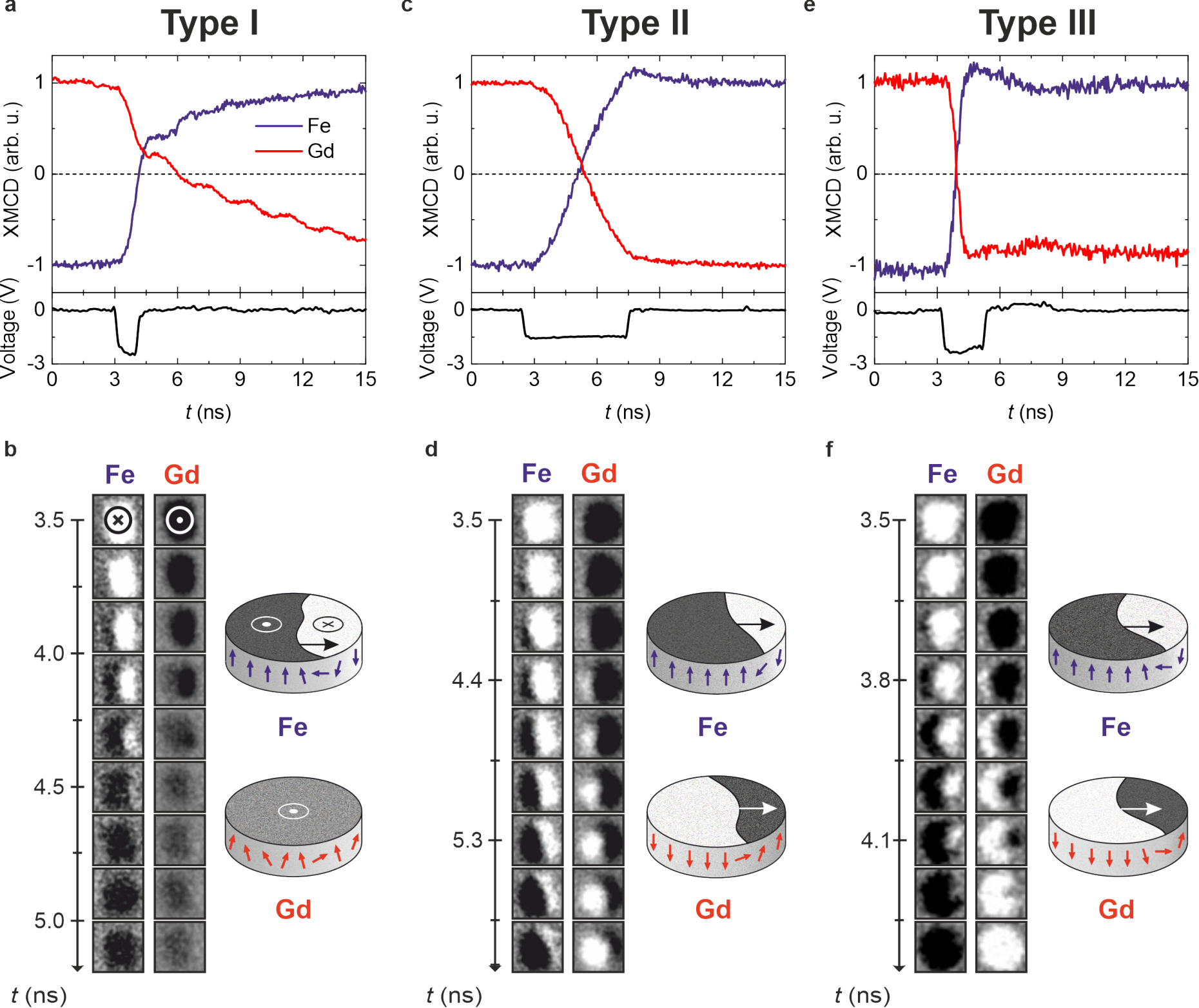Master-slave dynamics of ferrimagnets driven by spin-orbit torques
Ultrafast switching of ferrimagnetic order by an electric current reveals unexpected transient magnetic states that shed light on the sublattice magnetization dynamics in space and time.
Ferrimagnets like magnetite, the oldest known magnetic material, are more complex than ferromagnets. In the latter, all the magnetic moments are aligned parallel to each other. In ferrimagnets, they are organized in two or more sublattices with opposite magnetic orientation. This arrangement is akin to that of a third class of magnetic materials, antiferromagnets. However, whereas antiferromagnets do not possess a net magnetization, ferrimagnets do have a net magnetization because the magnetic moments of the sublattices do not exactly compensate each other. This combination of ferromagnetic and antiferromagnetic properties has raised strong interest in ferrimagnets. On the one hand, they can be studied with most of the techniques routinely applied to ferromagnets thanks to their finite magnetization. This is notoriously the greatest challenge posed by antiferromagnets. On the other, the antiferromagnetic coupling endows ferrimagnets with very fast dynamics. For instance, ferrimagnetic domain walls driven by an electric current can move at record speeds of the order of 5 km/s.
Particularly interesting are ferrimagnets comprising of rare-earth (RE) and transition-metal (TM) elements. GdFeCo and TbCo are two prominent examples. In these materials, the magnetic moments of Gd and Tb are coupled antiparallel to the moments of Fe and Co by the antiferromagnetic exchange interaction. For a long time, this coupling was considered so strong as to preserve the antiparallel orientation in any circumstance. Ten years ago, optical experiments have shown that this is not the case when RE-TM ferrimagnets are excited by intense ultrafast laser pulses, which locally heat the lattice and lead to the demagnetization of the RE and TM sublattices on the timescale of a few picoseconds (1 ps = 10-12 s). Our experiments showed that a different type of excitation, namely spin-orbit torques induced by injection of an electric current, can lead to the magnetic decoupling of the RE and TM sublattices on much longer timescales, namely nanoseconds, revealing unexpected aspects of magnetization switching in ferrimagnets as a function of their structure and elemental composition. Electric-driven switching of ferrimagnets is also relevant to integrate this material in spintronic devices.

We have studied the magnetization switching induced by spin-orbit torques in GdFeCo and TbCo by employing an X-ray pump-probe technique that combines time (70 ps), space (35 nm), and element resolution. We have observed three distinct switching regimes in which the magnetizations of the two sublattices either remain synchronized throughout the reversal process or switch following different trajectories in time and space, as shown in Fig. 1. The most striking finding is that, in the so-called type I dynamics, the RE and TM magnetizations switch asynchronously. The TM magnetization reversal is driven by the motion of domain wall across the sample, while the RE magnetization switches in a chaotic and turbulent way. As a consequence, the two sublattices form a transient ferromagnetic state that lasts up to 2 ns, much longer than the ~1-10 ps duration observed in optical experiments. We found, however, that this dynamics is not unique. In the type II and type III dynamics, the two sublattices are more strongly coupled and switch with only a short relative delay. Micromagnetic simulations and electron microscopy measurements identified the origin of the disparate and asynchronous dynamics with two factors: the different strength of the spin-orbit torques acting on the RE and TM magnetizations and the weakness and variability of the antiferromagnetic exchange interaction, which depends sensitively on the microstructure of RE-TM alloys.
Our results provide novel insight into the magnetization dynamics of antiferromagnetically-coupled materials, and have practical implications for engineering ferrimagnetic devices with maximum and uniform switching speed.
Selected publications
Asynchronous current-induced switching of rare-earth and transition-metal sublattices in ferrimagnetic alloys, G. Sala, C.-H. Lambert, S. Finizio, V. Raposo, V. Krizakova, G. Krishnaswamy, M. Weigand, J. Raabe, M. D. Rossell, E. Martinez, and P. Gambardella, Nat. Mater. 21, 640 (2022). Downloadarticle (PDF, 2 MB)vertical_align_bottom Downloadsupplementary information (PDF, 5.4 MB)vertical_align_bottom
Ferrimagnetic Dynamics Induced by Spin-Orbit Torques, G. Sala and P. Gambardella, Adv. Mater. Interfaces. 2201622 (2022). Downloadarticle (PDF, 3 MB)vertical_align_bottom
